Live Call Routing
Urgent matters cannot always be left to chats and emails. Sometimes your customers may wish to call you directly and if they cannot get through to you, not only do you now have a dissatisfied customer, the issue they were facing could trickle down to others.
TaskCall understands the need to keep your customers happy and allows you to ramp your service offering through Live Call Routing . Register and maintain a phone number of your choice with TaskCall and connect it to a service. Whenever a call is received to the number, we will forward the call to all the on-call responders of the service until someone responds. The caller stays on the same call and hears the ringtone while we attempt to connect to you no matter where you are.
Live Call Routing is only available for the Starter, Business and Digital Operations plans.
Pointers
- Once a call is received, TaskCall first determines what service the call should be forwarded to. It then tries forwarding the call to the on-call users of the escalation policy that is associated to that service. We first attempt to forward the call to the primary on-call user. If the call is not answered, then the call is forwarded to the Level 2 on-call user and so on. If there are multiple users on-call in the same level, the call will be forwarded to them in an arbitrary order, but attempts will be made to call each of them first before escalating to the next level.
- TaskCall will automatically create an incident when the call is received. This allows you to keep track of all the calls and increase visibility across the board. Even if a call is missed you will have the correct context to call back.
- The incident will be automatically acknowledged once the call is answered by someone.
- The incident will not generate notification alerts while the call is in progress. However, the routing can be configured to send notification alerts once the call ends.
- The routing behavior can be configured extensively - play a greeting message when call first comes in, present the caller a set of service options to select from and direct the call accordingly, control how long each forwarding attempt to on-call users should last, save voicemails and many more.
- Each live call routing is associated with a single phone number. This phone number is registered with telecommunication providers by TaskCall. You can search for availale phone numbers and select the one you want.
- Live call routing can only be created and edited by Admins and the Owner.
- Live call routing does not fall within the free trial period. If your account is on a trial period when you start using live call routing, you will still be billed for registering the phone number and the call minutes.
Create Live Call Routing
- Go to: Configurations > Live Call Routing > New Live Call Routing.
- You will first have to select a phone number from list of available numbers. Click Search phone number. A modal will pop up where you can search for numbers from a specific country, regional code and for toll-free numbers. After your search is rendered a list of available numbers will be displayed. Select the phone number you want.
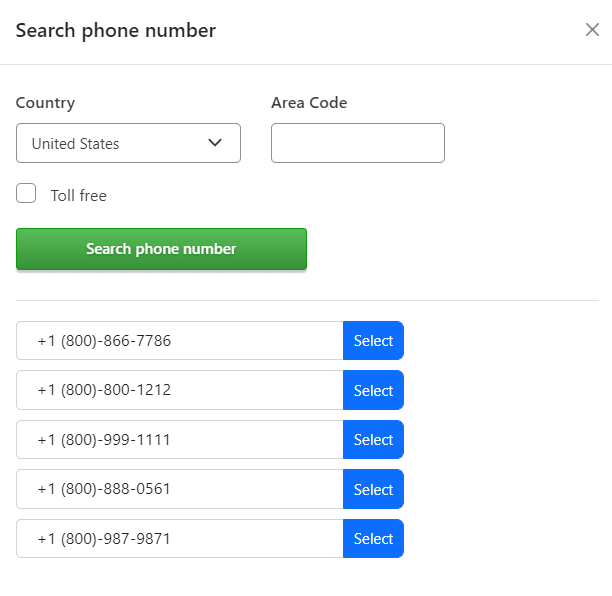
- Give the routing a name and describe what it is for.
- Configure the routing behavior.
- Click Save once you are done. Your request may take a few seconds to process as we have to register the number. Do not leave the screen.
Greeting
Greeting is the automated message the caller will hear when they dial. If you want options to be presented to the user to select from, then please mention them here. The greeting can be a text or a voice recording (only mp3 files are allowed). If no greeting is provided then TaskCall will initiate call forwarding immediately after the call is received.
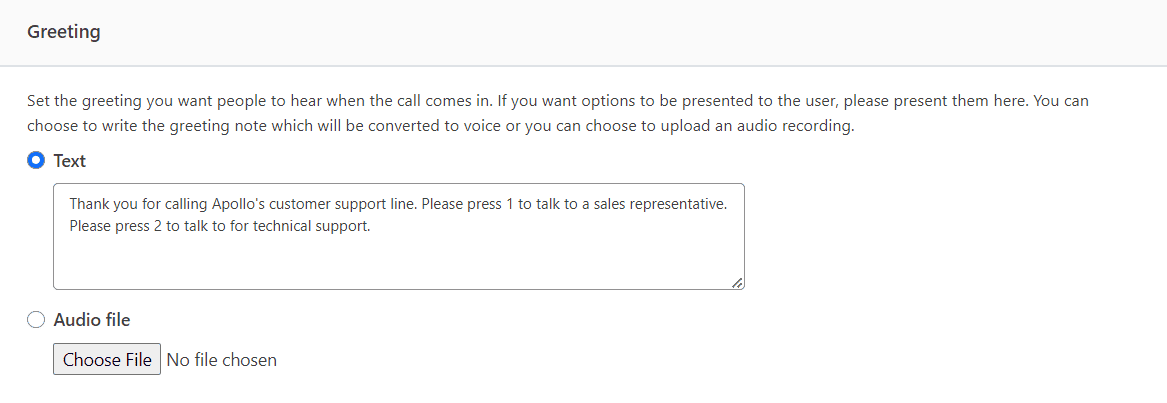
Greetings are not played for calls placed from a user's phone number
When a call is made to a live call routing number from a registered user's phone number, greetings are not played. This is because TaskCall first assumes that the user is trying to place an outbound call.
Outgoing calls are only allowed from users' phone numbers and can only be placed by dialing the live call routing number followed by the recipient's number.
Forwarding Services
Live calls are forwarded to TaskCall services. Services allow you to specify support hours and determine which escalation policy the call will be forwarded to.
Each live call routing must have a default forwarding service and setting it alone will suffice when the caller does not need to be presented with options. However, if options do need to be presented, then you must also add the services that each option must be forwarded to. The option must be a digit between 0 - 9. Once the caller selects an option by pressing the option digit on his dialpad, the call will be forwarded to the service corresponding to that option. If the caller selects an invalid option, the call is forwarded to the default service.
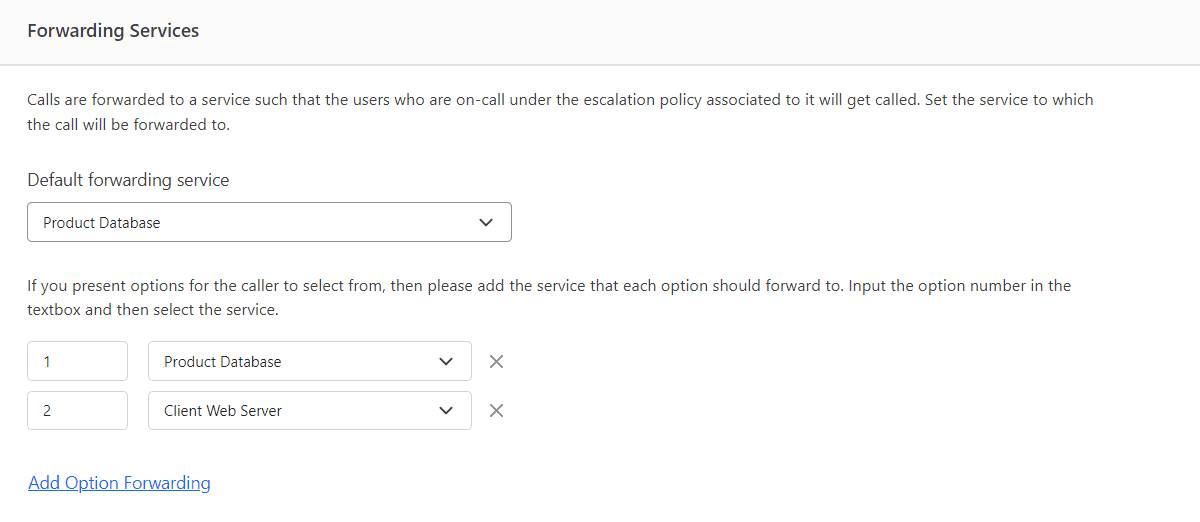
How to accept a routed call?
After users picks up the forwarded call, they will be connected with the caller directly unless the option to prompt for call acceptance is selected (see the routing settings below). If the option to prompt is selected, the prompt will be played as soon as the call is picked up. The on-call must press a key to be connected with the caller. If no key is pressed the call will not be connected. This also ensures that if the user's answering machine comes on, it does not get played to the caller.
Ending Note
Ending note is the automated message that will be played in the event that the call is not answered by any of the on-call users. It allows you to end the call in a pleasant note and ask the caller to leave a voicemail. If no ending note is provided, then the call will not go to voicemail and the call will end abruptly. The ending note can be a text or a voice recording (only mp3 files are allowed).
If the user leaves a voicemail, it may not be available immediately after the call ends. It may take us a minute or two to process the voicemail.
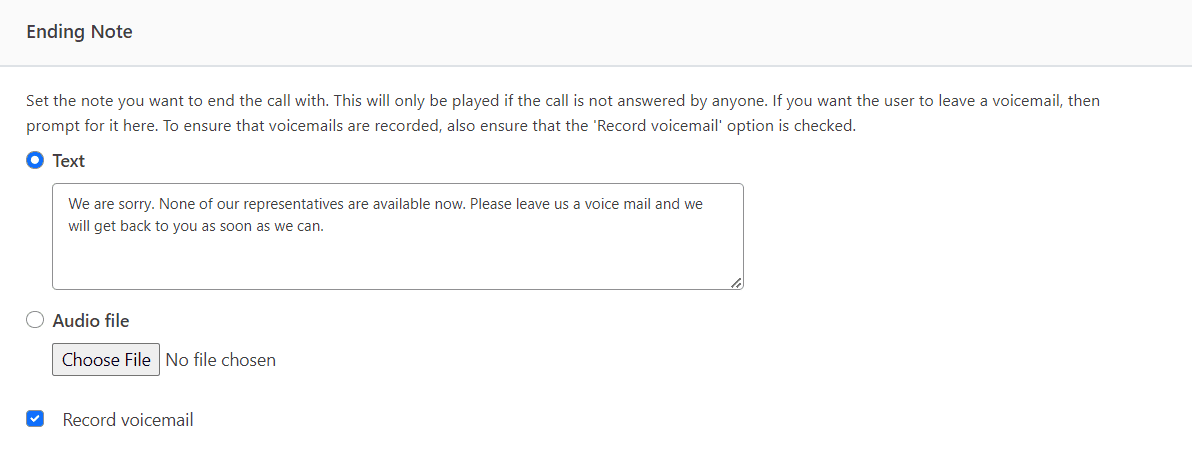
Routing Settings
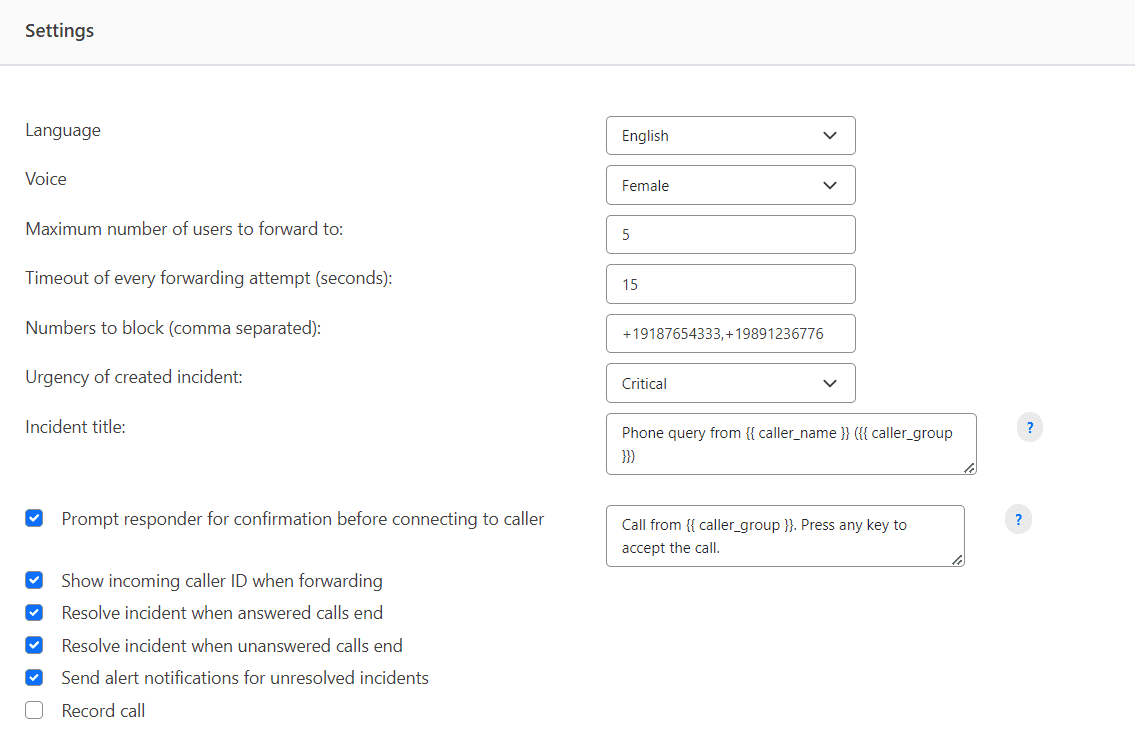
Settings allow you to configure some nifty features for the call handling and incident management.
- Language: This is only used when the greeting or the ending note is provided in text. Knowing the language allows the automated voice to better pronounce the words.
- Voice: This determines whether the automated voice should be of a male or a female. It is only used when the greeting or the ending note is provided in text instead of a recording.
- Maximum number of users to forward to: This is the maximum number of times the call will be attempted to be forwarded to on-call users. If the number of available on-call users is less than this number, then the system will continue to loop over the escalation policy and retry all the on-call users until the maximum number of forwards is reached.
For example, if the maximum forwards is set to 4 and the first 4 users the call is forwarded to do not respond, then the call will end right after that even if there are 8 on-call users in total in the escalation policy. On the other hand, if there were only 2 on-call users and neither of them answered, then the system will continue to retry them in the same order until the maximum forwards, which is set at 4 in this example, is reached. - Timeout of every forwarding attempt: This is the maximum number of seconds TaskCall will try to attempt to forward the call to a single on-call user. If the call remains unanswered after the set number of seconds, then the next on-call user will be tried. If it is not specified, it defaults to 20 seconds.
- Numbers to block: You can choose to block a list of numbers. The numbers should be comma separated and in their full format with the country code (example: +15567328980). The call will be rejected immediately after it is received if the incoming number matches any of the blocked numbers. You will not be billed for incoming calls from blocked numbers.
- Urgency of created incident: The urgency that will be set for the created incident. This will be important if notification alerts need to be sent out if the call ends unanswered.
- Incident title: The title of the incident. All notifications sent out for the call (if notifications are to be dispatched) will contain this incident title. Placeholders can be used to dynamically plug in variables into the title. Check the list of allowed placeholders to learn more.
- Prompt responder for confirmation before connecting to caller: Play a message to the on-call responder when they answer a call mentioning that they are being connected for a work call and make them accept it by pressing a key on the dial pad. If a key is not pressed, the call will not be connected and the live call routing flow will continue. This step gives responders more time to prepare and avoid unprofessional situations where family members accidentally pick up the call and are connected with clients. However, if this option is not selected, then the caller will be connected to the on-call responder as soon as the call is answered.
The prompt can be customized. Placeholders can also be used to dynamically enrich the prompt with insightful details like the name of the caller or the group the caller belongs to. The text is converted to speech and played to the on-call responder right after the call is answered. - Show incoming caller ID when forwarding: This allows you to determine whether the incoming phone number that will be displayed on the on-call user's phone will be that of the actual caller or the routing phone number. If this option is not selected, then the routing phone number will be displayed to the on-call user. The user can choose to save the routing number in reference to their work allowing them to differentiate work related calls and personal calls. It may help them respond to the call more formally and with more urgency.
- Resolve incident when answered call ends: TaskCall automatically creates an incident when a call is received on the routing phone number. This setting allows you to define whether the incident should be automatically resolved once the call ends after it is answered by someone.
- Resolve incident when unanswered call ends: This setting allows you to define whether the incident should be automatically resolved once the call ends even if it remains unanswered. Not resolving unanswered calls will help you bring missed calls to the forefront as the incident will remain open.
- Send alert notifications for unresolved incidents: Incidents created from live call routing do not generate notification alerts - email, push notifications, SMS and voice calls. This is done to reduce unnecessary noise. However, if the call remains unanswered, with this setting notification alerting can be turned on. The notification will be sent based on the urgency of the incident.
- Record call: Calls can be recorded for training purposes. However, it must be made clear to the recipient of the call that the call is being recorded in compliance with regulations. Please adhere to any other regulations of your local, state and federal authorities.
Call recording is only available for the Digital Operations plan. The option to record calls will be shown in the Settings section for accounts with the correct permissions. Additional fees also apply for call recording.
Remind to press any key to accept the call
If the call acceptance prompt option is selected, always end the prompt asking the responder to press any key to accept the call. If no key is pressed after the prompt is played, the responder will not be connected with the caller.
Placeholders
Placeholders can be used in the incident title and call acceptance prompt to contextualize the call. The following placeholders are allowed:
- {{ caller_name }}: Full name of the caller. If the caller's phone matches any of the stored people's phone number, then that person's full name will be plugged into this placeholder.
- {{ caller_group }}: Name of the group the caller belongs to. If the caller's phone matches any of the stored people's phone number and that person belongs to a group, then that group's name will be plugged into this placeholder.
- {{ routing_name }}: Name of the live call routing configuration.
- {{ from_number }}: The caller's number.
- {{ to_number }}: The number the call came into.
Default Values
Placeholders can be provided default values as a fallback like this {{ placeholder | default value }}. This default value will be used in case the actual value is not found. For example, if the incoming caller's number is not associated with any of the stored people, then no replaceable value will be found for the {{ caller_name }} placeholder. In such a situation having a default value set like {{ caller_name | new customer }} would replace the placeholder with the value "new customer".
People and Groups Permission for Placeholders
{{ caller name }} and {{ caller_group }} placeholders can only be used if the organization has access to People and Groups. People and Groups are only available with the Digital Operations plan. In other paid plans, they can be added with the Advanced Live Call Routing Add-on.
Outgoing Calls
Outgoing calls are only available for accounts with the Digital Operations plan. Calls can be made directly by dialing the routing call number in addition to the end recipient's number. If your routing phone number is +1 988-900-4787 and the end recipient's phone number is +1 677-080-2231 then by dialing in the following format +19889004787,16770802231# direct calls can be placed.
Outgoing call are only allowed from phone numbers that belong to registered users.
Pricing
Live call routing does not fall within the pricing of subscription plans. It is billed separately. There is a charge for each routing number and for the minutes of call time.
- Phone Number: $5 per phone number per month. Exceptions apply for certain countries.
- Call Time: $0.10 per minute for calls from US and Canada. $0.35 per minute for all other countries. The call time is rounded up to the minute.
- Call Recording $0.05 per minute of call recording. All call recordings (including voicemails) are available for a maximum of 3 months.
Countries
Routing phone numbers are only available for the countries listed below:
- Algeria
- Argentina
- Australia
- Austria
- Barbados
- Belgium
- Benin
- Bosnia and Herzegovina
- Botswana
- Brazil
- Bulgaria
- Canada
- Cayman Islands
- Chile
- Colombia
- Croatia
- Czech Republic
- Denmark
- Dominican Republic
- Ecuador
- El Salvador
- Estonia
- Finland
- France
- Georgia
- Germany
- Ghana
- Greece
- Grenada
- Guinea
- Hong Kong
- Hungary
- Iceland
- Indonesia
- Ireland
- Israel
- Italy
- Jamaica
- Japan
- Kenya
- Lithuania
- Luxembourg
- Macau
- Mali
- Mauritius
- Mexico
- Netherlands
- New Zealand
- Panama
- Peru
- Philippines
- Poland
- Portugal
- Puerto Rico
- Romania
- Singapore
- Slovakia
- Slovenia
- South Africa
- Sudan
- Sweden
- Switzerland
- Thailand
- Trinidad and Tobago
- Tunisia
- U.S. Virgin Islands
- Uganda
- United Kingdom
- United States
- Venezuela
- Vietnam